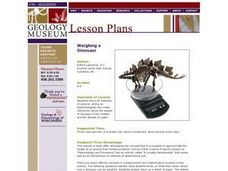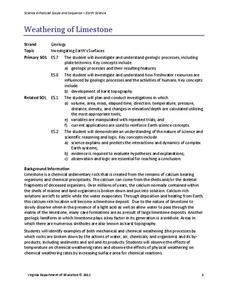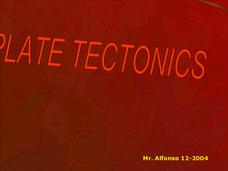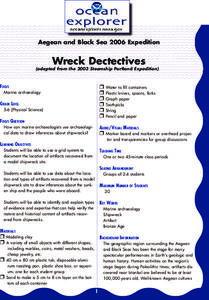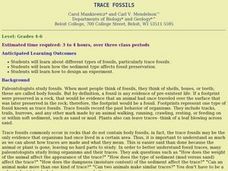Curated OER
The Earliest Primates
In this early primate worksheet, students will read information about the fossil evidence of the earliest primates. Students will complete 3 short answer questions based on their reading.
Curated OER
The Big Burp: Where's the Proof.
Students explore the Cambrian explosion and Paleocene extinction events. In this climate change lesson plan, students read articles to link evidence they find to extinction and climate change. Links to the articles are included in the...
Curated OER
Fossils: The Eras of the Earth's History
Young scholars research the four geologic eras of Earth's history. In this extension on a fossils lesson, students research the different eras of Earth's history. Young scholars use AppleWorks to create a bar graph containing information...
Curated OER
Scientific Method
In this scientific method worksheet, students read and discuss a 2 page article on the scientific method, match 3 founders of the scientific method with what they found or produced, answer 4 statements as true or false, list 3 crucial...
Curated OER
Law of Superposition
Students identify the law of superposition and it states that beds of rock in a series are laid down with the oldest at the bottom and younger layers on the top. They construct a legen for a block diagram and construct a block diagram...
Curated OER
It's All In The Rocks
Learners think critically to determine fact or inference when examining sedimentary layers with embedded fossils. Geology and evolutionary biology are introduced. They individually write a story about various diagrams and share their...
Curated OER
What do you know about earthquakes??
Ninth graders compare and contrast various writing styles and distinguish technical writing from other writing techniques. They assess personal knowledge regarding earthquakes and earthquake preparedness.
Curated OER
Stick-Slip Movement
Ninth graders operate a model to observe the type of motion that occurs at a fault during an earthquake. They explore the effects of several variables. Students measure movement, calculate averages and plot and graph information.
Curated OER
Fossils
In this earth science worksheet, learners use the clues given at the bottom of the sheet to solve the crossword puzzle on fossils. They identify specific names of fossils and how to make a mold of one.
Curated OER
Weighing a Dinosaur
Students role play as paleontologists who make inferences about the weight of dinosaurs. They use models and the density of water to make these inferences.
Curated OER
Physiological Adaptations
Students investigate the concepts of genetics and how it is tied to the variations found within different species and how it is tied to adaptations. They review the theory of evolution and factors found to help create variation. The...
Curated OER
Lord of the Rings - A Study of Tree Rings
Learners examine trees and discuss how the environment effected the tree. They also predict what the area look like in fifty years.
Virginia Department of Education
Weathering of Limestone
We all know limestone weathers, but what affects the rate of weathering? Young scientists investigate the physical and chemical weathering of limestone (chalk) through experimentation. First, they conduct trials with different-size...
Biology Class
Plate Tectonics
A great reference to include in the classroom and on your class website, the presentation covers the following topics: Alfred Wegener's theory of continental drift, Pangea, layers of the earth and their properties, convection, plate...
Curated OER
Exploring Mars
Students, working in small groups construct scale models of the planets and solar system. They examine images of Mars and discuss what might have caused the features. They record facts about their planetary research in their journals and...
National Park Service
Living & Non-Living Interactions
What better way to learn about ecosystems than by getting outside and observing them first hand? Accompanying a field trip to a local park or outdoor space, this series of collaborative activities engages children in learning about the...
It's About Time
Mass Extinction and Fossil Records
The focus of a fossil-based lesson uses graphs and charts that allow young paleontologists to make inferences about events of mass extinction. They must apply their previous knowledge about fossil records in this final lesson of the...
Curated OER
How Do New Species Form?
Learners read an article by Niles Eldridge about species and the environment and break into small groups to discuss it. They write essays noting strengths and weaknesses of punctuated equilibrium and gradualism, or other topics listed.
Curated OER
Half Life Lab
Seventh graders model radioactive decay using pennies, collect data from their model, apply scientific visualization techniques to their data and create animated models explaining the concept of radioactive half-life.
Curated OER
Digging Into Science: Final Analysis
In this archeological excavation instructional activity, students complete 9 short answer questions based on a simulated archeological activity they performed in a small group.
Curated OER
Wreck Detectives
Junior archaeologists examine types of artifacts from the Bronze Age on the internet. In collaborative groups, they create a story about a ship from this period and then construct a model of the ocean floor after their ship has sunk....
Curated OER
Science: Making Trace Fossils
Students explore types of fossils and discover how sediment affects fossil preservation. They focus their study on trace fossils and create their own using sediment, water, and a small organism such as a snail or lizard. Students use...
Curated OER
Dinosaur Detectives
Students write a report about a paleontologist. In this paleontology lesson, students research and write a report about a noted paleontologist. They discuss the importance of technology to paleontologists and how paleontologist excavate...
Curated OER
Rock Cycles, Crayon Cycles
Students examine the rock cycle and the path that rocks go through to rearranged in different ways. They define key vocabulary terms, then in small groups conduct a variety of experiments using crayon shavings as simulated rocks and...











